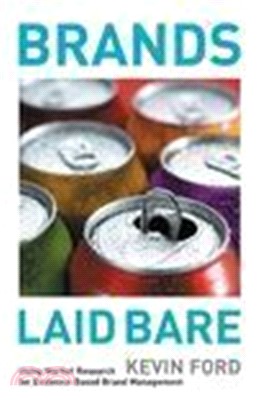| FindBook |
有 1 項符合
Brands Laid Bare: Using Market Research for Evidence-Based Brand Management的圖書 |
 |
Brands Laid Bare: Using Market Research For Evidence-Based Brand Management 作者:Kevin Ford 出版社:JOHN WILEY & SONS,LTD 出版日期:2005-02-25 規格: / 精裝 / 168頁 |
| 圖書館借閱 |
| 國家圖書館 | 全國圖書書目資訊網 | 國立公共資訊圖書館 | 電子書服務平台 | MetaCat 跨館整合查詢 |
| 臺北市立圖書館 | 新北市立圖書館 | 基隆市公共圖書館 | 桃園市立圖書館 | 新竹縣公共圖書館 |
| 苗栗縣立圖書館 | 臺中市立圖書館 | 彰化縣公共圖書館 | 南投縣文化局 | 雲林縣公共圖書館 |
| 嘉義縣圖書館 | 臺南市立圖書館 | 高雄市立圖書館 | 屏東縣公共圖書館 | 宜蘭縣公共圖書館 |
| 花蓮縣文化局 | 臺東縣文化處 |
|
|
- 圖書簡介
The way we relate to brands has changed. Once, brand management was about doing things to people, and choices were made by brand managers not consumers. Now the focus has shifted towards the customer, empowering them to make choices and treating them as individuals rather than an amorphous mass. A consequence of this is increased interest in understanding people as a foundation for brand management. And this is where market research can come in. By drawing on market research to understand consumers, marketers can better understand how to manage their brand. Exploring a spectrum of 12 customer needs and drawing on first-hand research evidence, Kevin Ford provides a proven framework for understanding what people are really looking for from a brand - and delivering it.
- 目次
Preface.
Acknowledgements.
1. What do People Want from a Brand?
Introduction.
Brand Associations.
Consumer Needs.
The Universal Needs Map.
2. Further Insight into Needs from Other Perspectives.
Different Dimensions.
The Relationship Between Consumers and Brands.
Other Psychological Systems.
Conclusions and Implications for Brands.
3. Brand Equity: How do People Assess your Brand Overall?
The Concept of Summary Evaluations.
Work on Attitudes, not Behaviour.
Identifying Candidates for Brand Equity Building Blocks.
Main Attitudinal Building Blocks.
Combinations of the Main Building Blocks.
4. Touchpoints and Brand Physique.
A Framework for Physique, Perceptions, Needs and Touchpoints.
The Influence of each Touchpoint.
Customer Satisfaction.
Communications.
Branding Devices.
5. Segmentation and Targeting: Where should you Aim?
Why Aim for Target Segments?
A General Approach to Segmentation.
Types of Segmentation.
Getting the Best out of Segmentation.
6. Turning Brand Equity into Sales.
Brand Pull.
Brand Push.
The Outcomes or Benefits of a Strong Brand.
Behavioural Brand Loyalty.
7. Ups and Downs: Today is Fine, How About Tomorrow?
Forces that Drive Brands Up or Down.
The Market Context.
The Brand’s Marketing and Consumer Response.
Social Trends.
The Future for Brands.
Index.
|











